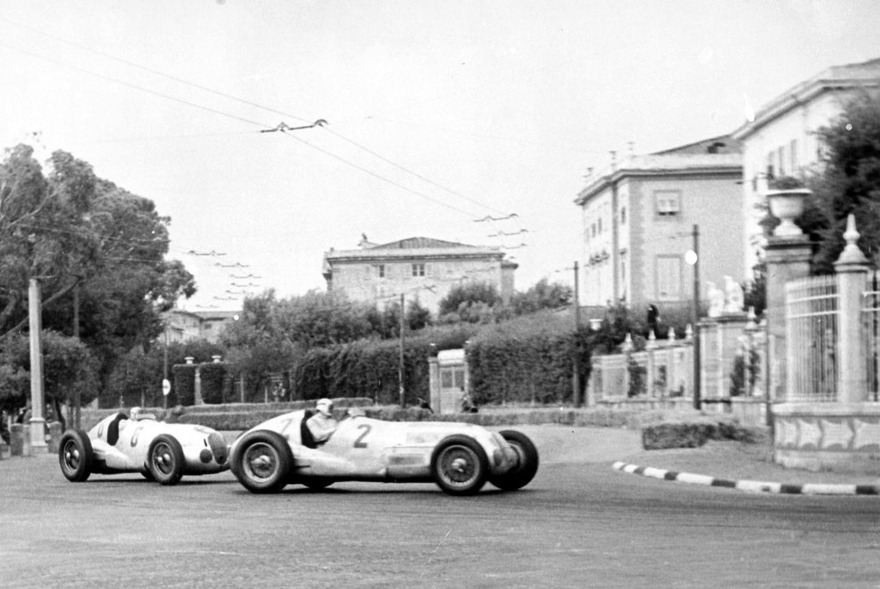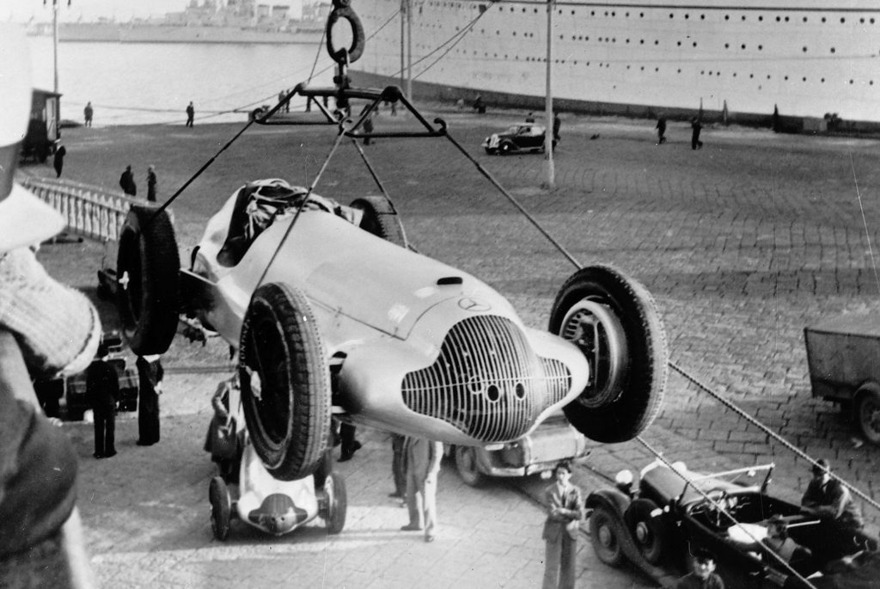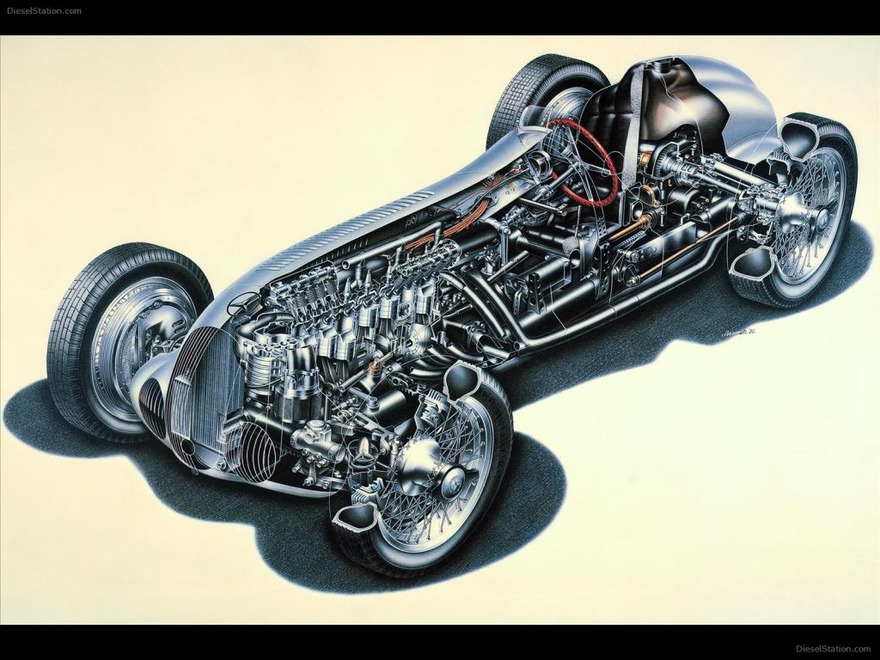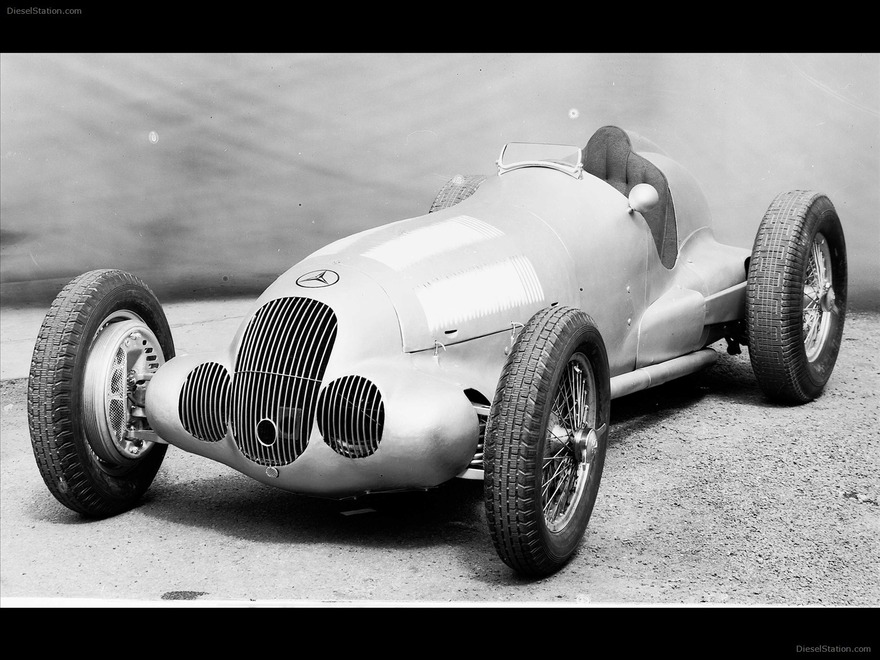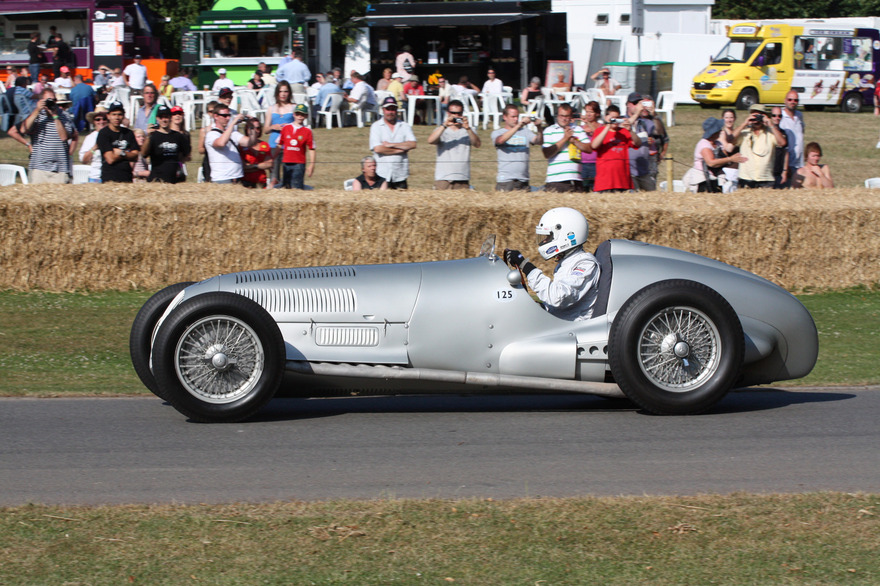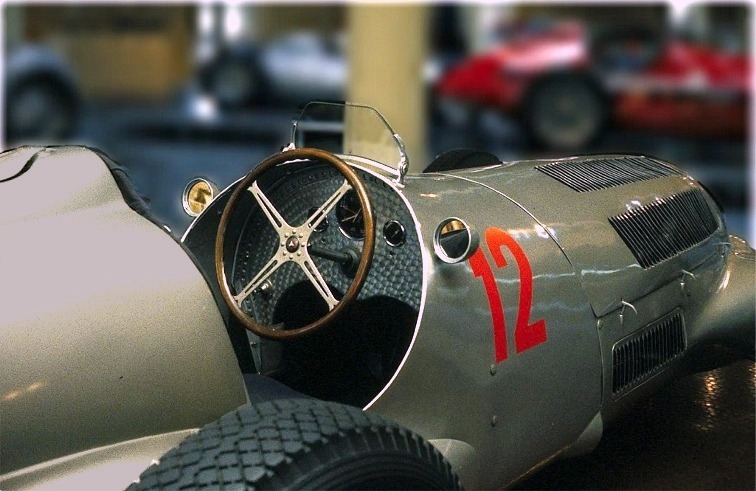Beginning of the XX century. The era of the Germans on the racetracks Only Italians could compete them on a serious level. But since 1934and until the WWII Mercedes-Benz and Auto-Union were on top. Their superiority over the competitors was so great that this period of motor racing was called the era of the hegemony of the Teutons.
And though the fate was not always lucky, and victories were not so easy Mercedes managed to create a real supercar, which became the champion.
After Italian victory in 1935, when Tazio Nuvolari won with the Alfa Romeo, after the defeat of W25E in the season «Grand Prix 1936» Mercedes-Benz designers have decided to build a completely new model W125.
From the memoirs: «Again and again our visitors are impressed with the Mercedes-Benz W125, which hangs on a vertical wall. Together with six other record cars, this one adds an impressive touch to the atmosphere of „Silver Arrows — Races and Records“ hall. Even acoustics here is kept closely to the atmosphere of the race track, „explains Michael Bock, head of Mercedes-Benz Classic.
Race car was built under the management of Fritz Nallinger and Rudolf Ulenhaut. Instead of the independent rear suspension, «De Dion» dependent mechanism was installed, which greatly improved the handling of the car. Inline 8-cylindered engine with 5.66 liters of volume made fantastic output of 646 hp. However, this figures were shon only when operating on alcohol mixture. The car was ready for the attack.
But in the first race of the Grand Prix 1937 — Grand Prix Belgium — double victory was taken by Auto-Union racers. And phenomenal Tazio Nuvolari could not even compete German team with his old Alfa.
However, if you don’t give up but go ahead you can achieve a lot. So, after the Belgian stage Mercedes-Benz racers had a series of victories. First of all, in Germany Caracciola won with 46 seconds ahead of his friend and teammate Manfred von Brauchitsch,.
At that time when on the Formula 1 tracks began to dominate turbocharged engines, the W125model was the most powerful car of Grand Prix class. And this testimony was the fantastic duel between German pilots in the streets of Monte Carlo. The chief, Neubauer, was so afraid of technical problems or accidents that continuously signaled them to reduce the speed. But Rudolf Caracciola and Manfred von Brauchitsch, raced through the streets as if they were connected by an invisible thread.
The tense three-hour struggle. And here the first finished Manfred von Brauhich, quicker than Caracciolo for 46 seconds. He won them back! But the most interesting is that adrenaline euphoria made Mercedes racers two laps quicker than Christian Kautz who drove the same Mercedes-Benz W125. So, for the first time in the history of the Monaco Grand Prix, an average speed of over than 100 km/h was shown.
Then were three consecutive victories Rudolf Caracciola in Switzerland, Italy and Czech Republic. Then was Bremgarten when racers Mercedes-Benz took the first 3 places. And even in Livorno, where the Gran Premio d'Italia for the first time in 15 years was not held in Monza. And on the Masaryk track they won 1st, 2nd and 4th places. The fate favored the Germans. And Rudolf Caracciola became the European Champion in the 2nd time in his career.
But the main record was still ahead. It happened that in 1938–1939 the AIACR (International Association of automobile clubs Reconnus) established a new racing regulations, which tried to equalize the chances of charged and atmo cars. Maximum volume of the engine of the first ones was limited to 3 liters, the second ones — 4.5 liters. The minimum weight of the car was set depending on the volume of the engine and for big engines it was 850 kg. Most participants such as: Alfa Romeo, Auto Union, Bugatti, Maserati and Mercedes-Benz — used supercharged engines. And only two French companies — Delahaye and Talbot — have equipped their cars with 4.5-litered, atmospheric engines. The first competition ended with a surprise: Rene Dreyfus won driving Delahaye. But no one doubts that anyway it willl be a year of success of German cars. So it happened. After the Grand Prix of Pau in Mercedes decided to beat everyone.
The constructors built an incredible car with incredible power. Silver Arrow was equipped with a 12-cylindered engine with two superchargers, and also had a special coverage of the whole body with a tapered tail. For the record purposes Mercedes W125 got special aerodynamically optimized body shapes. This body type was not usual for the racing cars of that time, and Mercedes-Benz had successfully used these developments in races. But, of course, is was not all in improvements. The experiments in the wind tunnel helped the engineers to reduce the air drag coefficient to the sensational value Cd = 0,157. This became possible by the use of a small air intakes in the front. As a result, the car was able to «breathe» the amount of air required to operate 5.6-litered V12 MD 25 DAB / 3-type and this made incredible 736 hp of power. Engine cooling was done without the use of fresh air, a 500 liter tank with ice and water helped to cool the engine.
Rudolf Caracciola, who was the leading driver of Mercedes-Benz racing division, set a record on the road between Frankfurt and Darmstadt. Brave racer managed to reach the mark of 432 692 km/h. In addition, there is a note that says that earlier he reached 432.36 km/h. These figures represent average values measured during the passes, made on the road in the opposite directions. So, in January 28th of the year 1938, Mercedes-Benz W125 set a world speed record on a public road, which still is not beaten.
«We can argue about who was the first inventor of the car, but without doubt the birthplace of the car is Stuttgart. After all, in Stuttgart, in a greenhouse converted into a workshop — which is now a place of pilgrimage for car fans and is an automotive inner sanctum — the inventors Gottlieb Daimler and Wilhelm Maybach invented and collected the first light petrol engine. It happened in 1885, and Stuttgart became an automotive star which is still bright today. Outstanding „automobile“ place of interest in Stutgart is a „Mercedes-Benz“ museum, the only museum in the world, which presents every automotive milestone from the very beginning. In the original museum building, seen from afar, are demonstrated 160 rare oldtimers, that make admired cries even from those who is not fond of cars. »

